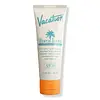What's inside
What's inside
 Key Ingredients
Key Ingredients

 Benefits
Benefits

 Concerns
Concerns

 Ingredients Side-by-side
Ingredients Side-by-side

Zinc Oxide
Cosmetic ColorantAllantoin
Skin ConditioningAloe Barbadensis Leaf Extract
EmollientButyrospermum Parkii Butter
Skin ConditioningCaprylhydroxamic Acid
Caprylic/Capric Triglyceride
MaskingCapryloyl Glycerin/Sebacic Acid Copolymer
Skin ConditioningCaprylyl Caprylate/Caprate
EmollientCaprylyl Glyceryl Ether
CleansingCucumis Sativus Fruit Extract
EmollientDicaprylyl Carbonate
EmollientDiheptyl Succinate
EmollientGalactoarabinan
Glycerin
HumectantHelianthus Annuus Extract
EmollientMagnesium Sulfate
Methyl Dihydroabietate
Niacinamide
SmoothingOryza Sativa Bran Extract
Skin ConditioningPolyglyceryl-2 Oleate
EmulsifyingPolyglyceryl-2 Stearate
EmulsifyingPolyhydroxystearic Acid
EmulsifyingPropanediol
SolventRosmarinus Officinalis Leaf Extract
AntimicrobialTocopherol
AntioxidantTriethoxycaprylylsilane
Water
Skin ConditioningZinc Oxide, Allantoin, Aloe Barbadensis Leaf Extract, Butyrospermum Parkii Butter, Caprylhydroxamic Acid, Caprylic/Capric Triglyceride, Capryloyl Glycerin/Sebacic Acid Copolymer, Caprylyl Caprylate/Caprate, Caprylyl Glyceryl Ether, Cucumis Sativus Fruit Extract, Dicaprylyl Carbonate, Diheptyl Succinate, Galactoarabinan, Glycerin, Helianthus Annuus Extract, Magnesium Sulfate, Methyl Dihydroabietate, Niacinamide, Oryza Sativa Bran Extract, Polyglyceryl-2 Oleate, Polyglyceryl-2 Stearate, Polyhydroxystearic Acid, Propanediol, Rosmarinus Officinalis Leaf Extract, Tocopherol, Triethoxycaprylylsilane, Water
 Reviews
Reviews

Ingredients Explained
These ingredients are found in both products.
Ingredients higher up in an ingredient list are typically present in a larger amount.
Glycerin is already naturally found in your skin. It helps moisturize and protect your skin.
A study from 2016 found glycerin to be more effective as a humectant than AHAs and hyaluronic acid.
As a humectant, it helps the skin stay hydrated by pulling moisture to your skin. The low molecular weight of glycerin allows it to pull moisture into the deeper layers of your skin.
Hydrated skin improves your skin barrier; Your skin barrier helps protect against irritants and bacteria.
Glycerin has also been found to have antimicrobial and antiviral properties. Due to these properties, glycerin is often used in wound and burn treatments.
In cosmetics, glycerin is usually derived from plants such as soybean or palm. However, it can also be sourced from animals, such as tallow or animal fat.
This ingredient is organic, colorless, odorless, and non-toxic.
Glycerin is the name for this ingredient in American English. British English uses Glycerol/Glycerine.
Learn more about GlycerinWater. It's the most common cosmetic ingredient of all. You'll usually see it at the top of ingredient lists, meaning that it makes up the largest part of the product.
So why is it so popular? Water most often acts as a solvent - this means that it helps dissolve other ingredients into the formulation.
You'll also recognize water as that liquid we all need to stay alive. If you see this, drink a glass of water. Stay hydrated!
Learn more about Water